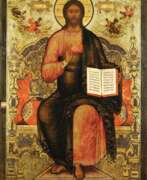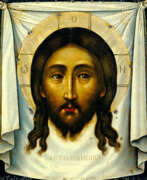Tsardom of Russia 17th century


Gury Nikitin (Russian: Гурий Никитин (Гурий Никитич Кинешемцев), was a Russian painter and iconographer born in 1620 in Kostroma, Russia, where he also died in 1691. Known primarily for his wall paintings, frescos, and iconography on wood panels, Nikitin was a leading figure in Russian art, particularly noted for his role in the Kostroma Brotherhood of Painters, an artist guild he led until his passing. His works are celebrated for combining biblical themes with vivid scenes from daily life, showcasing a perfect blend of monumentality and decorative art, particularly evident in his most famous icon, the Icon of St. Quiricus and St. Juliet.
Nikitin's artistry is marked by its adherence to canonical themes while introducing complex compositions inspired by Johannes Piscator's bible. Under his guidance, the most significant Russian fresco painting ensemble of the 17th century was created, especially noted in the Church of Elijah the Prophet in Yaroslavl. Art historians admire Nikitin for his unique style, integrating non-mirror symmetry, contrasts of light and shade, and a vibrant color palette that enhances the decorative appeal of his compositions.
For collectors and experts in art and antiques, Nikitin's oeuvre represents a crucial period in the development of Russian iconography and fresco painting. His contributions have left a lasting impact on the artistic landscape of the 17th century, making his works a valuable study for those interested in the evolution of Russian art.
To stay updated on exhibitions and auctions featuring Gury Nikitin's work, signing up for updates is recommended. This will ensure that collectors and enthusiasts are well-informed about new sales and events related to this remarkable artist's legacy.


Simon (Pimen) Fyodorovich Ushakov (Russian: Симон (Пимен) Фёдорович Ушаков) was a leading Russian icon painter of the 17th century, known for his significant contributions to the art world and the Russian Orthodox Church's comprehensive reform. Born circa 1626 in Moscow, Russia, Ushakov became a prominent figure in Russian art, blending traditional iconography with innovative techniques that heralded a new era in religious and secular painting.
Ushakov's work was characterized by the use of bright, fresh colors and exquisite, curving lines that reflected a proto-baroque influence. This style caught the eye of Patriarch Nikon and Tsar Alexei Mikhailovich, leading to Ushakov's appointment to the Kremlin Armoury in 1664. Despite some conservative criticism for his "Western" approach to iconography, Ushakov's icons, such as the famous "The Last Supper" (1685), "Our Lady of Vladimir" (1668), and "Archangel Michael Trampling the Devil Underfoot" (1676), have become celebrated pieces of Russian art, housed in prestigious museums like the State Historical Museum, State Tretyakov Gallery, and the State Russian Museum.
Ushakov was not only a painter but also a theorist and educator, publishing a treatise on icon painting and influencing future generations of artists. His pupils, including Georgy Zinoviev, Ivan Maximov, and Mikhail Malyutin, carried on his legacy, blending traditional and Western styles into Russian iconography well into the 20th century. Ushakov's icons, known for their spiritual depth and artistic innovation, played a pivotal role in the development of Russian painting and helped foster interest in Russian art in Western Europe.
For collectors and experts in art and antiques, Ushakov's work represents a bridge between the spiritual and the innovative, marking a significant period in Russian art history. His contributions to iconography and secular painting have left an indelible mark on the art world.
To stay updated on exhibitions and auctions featuring Simon (Pimen) Fyodorovich Ushakov's work, sign up for updates. This subscription will ensure you're informed about new product sales and auction events related to this key figure in Russian art history.